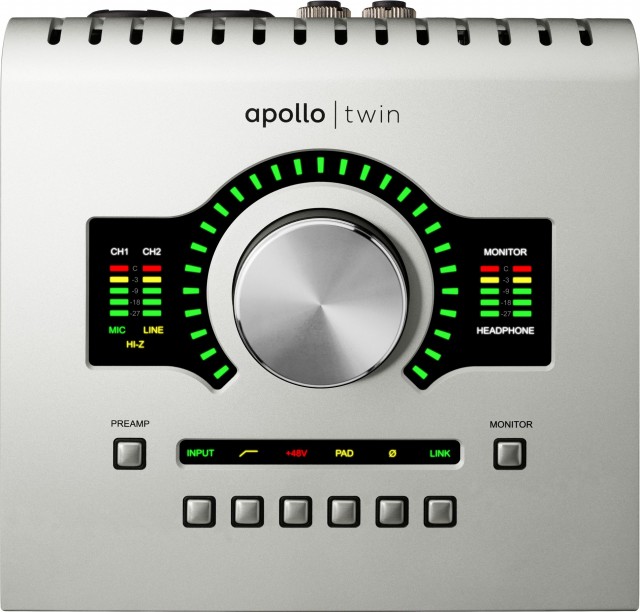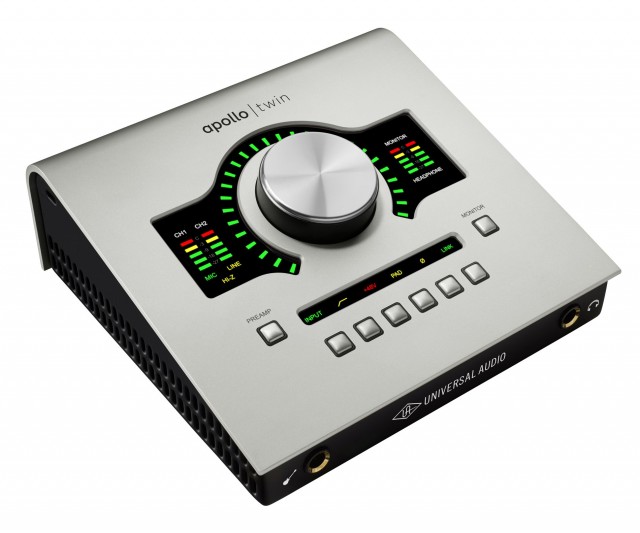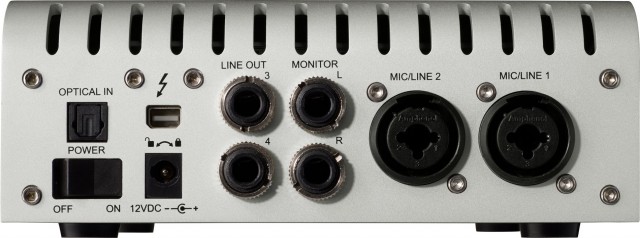
It’s a premium Thunderbolt audio interface with DSP power – good so far. But what sets the new Apollo apart is that the software can now intelligently control the audio interface, making its models of favorite analog gear more accurate. Photos courtesy Universal Audio.
Universal Audio’s new Apollo Twin (in SOLO and DUO variants, starting at US$699) gives you quite a lot of value on a single Thunderbolt connection to your Mac. It’s shipping now.
It’s an audio interface, with connections for line, mic, or instruments. It’s a real-time DSP processor, adding the ability to run UA’s suite of (mostly analog-modeling) sound processing goodies. (SOLO/DUO refers to how much DSP muscle you get.) And it’s a bundle of UA models of analog hardware, including a rather nice pair of limiters, an EQ, amp models, and tube preamps.
If you think they’re hoping guitarists and vocalists will pick this up, you’re probably right. And this is the first plug-and-play solution that brings UA’s DSP and mic pre / audio interface tech within reach of an individual musician or producer on a budget.
Smarter Analog Modeling, Input to Output
But it’s when the hardware and software start to combine that things start to get really interesting. CDM had a briefing with UA’s Gannon Kashiwa last week on the technical side. UA is pushing what they call “Unison Technology” – basically, a set of software behaviors that make analog models behave as expected when you connect your gear to record.
The problem had been this: no matter how good the software model of analog gear, the software didn’t have any idea of how you were recording into it. Part of what makes a tube or solid-state mic preamp sound a certain way is the whole signal chain, from input to output. By controlling the hardware, UA says they can more effectively simulate those behaviors, including impedance, “sweet spots” in the gain stage, and other behaviors of input circuits.
If you know this gear, you can then get more satisfying results. If you don’t, you might instead just get a better feeling from using the software – there’s a reason those classics became classics.
Amanda Whiting explains to CDM a little more about how this works:
In a nutshell, Unison allows for us to control the mic preamps before the A/D conversion. When a mic preamp modeling plug-in is inserted, Unison allows Apollo Twin’s mic preamp to physically match the impedance and gain structuring of the original hardware the plug-in is modeling. So for example, with the 610-B preamp plug-in that comes with Apollo Twin, when you pull up the plug-in, we change Apollo Twin’s preamp impedance from its standard 5.4k Ohms to 500 Ohms or 2k Ohms, depending on the switch setting on the plug-in.
This feature will also be available for Apollo DUO and QUAD this spring, in a free forthcoming software release.
Thunderbolt, Live DSP, and Near-Zero Latency Monitoring
Combine this with Thunderbolt, and you have something special. As I said of MOTU’s 828x, the issue with Thunderbolt isn’t that you get lower latencies; FireWire 800 at a fraction of the speed is already fast enough to handle high-bandwidth audio. The issue is getting reliable low-latency performance, even when other devices are connected, and being able to connect loads of stuff without worrying. UA spoke highly to CDM of the reliability they’ve gotten out of Thunderbolt.
Coupled with flexible live monitoring and the ability to track through UA’s own plug-ins with that same level of performance, latency on the Apollo becomes something you don’t worry about any more.
Part of the advantage here, as on the earlier Apollo, is that you can play without adding any latency on the computer at all. You can plug in your instrument or mic, and add (non-destructive) compressors, EQs, and amp models, and track through them with new-zero latencies (< 2 ms). That also means the Apollo Twin becomes a viable interface for playing live with UA's amp models, with great low-latency to match.
[caption id="attachment_32123" align="alignnone" width="640"] The emphasis on preamp function extends to the hardware interface design. At top, your (analog) level control is front and center, with preamp metering on the left and monitor/headphone metering on the right. You are … fully metered.
The emphasis on preamp function extends to the hardware interface design. At top, your (analog) level control is front and center, with preamp metering on the left and monitor/headphone metering on the right. You are … fully metered.
At the bottom, you get dedicated controls for the Preamp, so you can play with these new behaviors without looking at the screen. (Type, HPF, 48V, PAD, 0̷, LINK), plus buttons for switching the focus from Preamp to Monitor.[/caption]
Tech Details
Onto the actual hardware and software…
The Apollo Twin innards come straight from the earlier Apollos. These are simply some of the finer audio interfaces on the market, with or without the DSP platform, with the same 24/192 conversion.
Also, monitoring is “digitally-controlled analog” – that is, you get an analog listening level, but with digital control. It’s funny; this really does make a difference. You forget about it, until there’s some point in a long studio session where you just notice while adjusting monitoring levels – and then you definitely notice it when you go back to a lower-end audio interface.
For guitarists (or, yes, bass players), Hi-Z and headphone are right on the front.
Hardware specs:
- 2 mic/line preamps
- 2 line outputs
- Hi-Z instrument input
- Headphone out
- 2 analog monitor outputs (digital-controlled analog)
- Optical connection for up to 8 additional channels (ADAT or S/PDIF). Someone asked about why this is included on these interfaces; my guess is that most people using these connections are using outboard digital mixers.
The software bundle includes the new 610B, Softube amps, and the “legacy” edition of some other UA greats:
- New 610B Preamp – this is the one that adds the new Unison modeling, and builds on UA’s long (pre-digital) history in preamps
- Softube bass and guitar amps “Amp Room Essentials.” These are a lot of good, raunchy fun; it’s not hard to find amp models out there, but Softube is making some of the more playable ones. And yes, for us non-guitarists, we can enjoy these, too, on keys or drum loops or whatnot. And if you’ve got an electric violin…
- LA-2A / 1176 limiting/compression.
UA is kind of giving away the store, because these are their best compressors.Actually, as a reader observes, these are the older “legacy” versions – checking. They make sense as the ones to bundle, either way, but the new models are just spectacular. - Pultec EQP-1A, Pulteq Pro – and their best EQs, modeling the exceptionally musical feel of the Pulteq, which has an almost magical ability to dial in the frequencies you want, and is a radically different experience from the modern digital EQs you’re used to using. Correction: Again, the newest releases of these are the best; these are the good-but-not-best legacy versions.
- RealVerb Pro. Advice: save up for the EMTs.

Plug-ins available for the UA DSP platform, seen here tragically floating in space, moments before asphyxiation. The part of the new 610B will be played by Sandra Bullock, who I’m told brings a sense of gravitas to her depiction of its bi-directional analog modeling features.
The 610B is the interesting one. The plug-in actually adjusts the hardware’s impedance, analog gain structure (think headroom), and component behaviors. Every tube, every transformer, every inductor is modeled in the DSP code in the plug-in, but as you turn the knob on the preamp, the plug-in is also changing the way the hardware itself is operating.
I’m a nerd, so even if this didn’t work, I’d find it fascinating (plug-ins intelligently controlling your hardware – AI audio interfaces). But testing this will be a lot of fun, as I’m keen to look more closely at how it works in practice.
Compatibility:
Mac only – for now. I want to see some Thunderbolt PCs, people.
OS X 10.8.5, 10.9.1 (but if you have a Thunderbolt-ready Mac, you probably have those)
AAX 64, AU, RTAS, VST plug-ins
Thunderbolt 1 or 2 (Thunderbolt 2’s added bandwidth really doesn’t matter to the vast majority of audio applications)

S***. I forgot ALL my cables. Now I have to go back to the studio, until someone creates digital modeling of analog cables.
The Soloist’s Apollo?
The Apollo Twin isn’t UA’s first audio interface. I’ve been working with the original Apollo for some time. And while UA’s main push is of course for their own plug-in DSP platform – they hope you’ll get hooked and buy more analog models – the interface is probably what I find most irreplaceable about the Apollo. It’s exceptionally reliable (rock-solid low-latency), the mic pres are flawless, hardware management is easy to use, and the ability to add just three or four UA processors I can find invaluable on top of it (the Pulteq EQs and beautiful EMT reverbs springing to mind – desert island stuff). It’s just been tough to recommend the platform. Having a full rack-space audio interface is overkill in live situations when size and weight are at a premium. And it’s pricey, running a couple grand or more.
The Apollo Twin gives you that level of power in a portable, affordable box. And there are enough plug-ins included at the start that even if you don’t buy more UA add-ons, you could be reasonably happy with just this box and its bundled software.
There is one gotcha – the cheaper Solo might not have enough processing power if you do decide you like those DSP plug-ins, meaning the US$899 DUO is probably the smart buy if you want to go this route. And I would recommend budgeting for the revised Pulteqs and some EMT reverbs to really exploit the platform, which means spending a little more.
But UA has an interesting entry here that’s more than just a combination of inputs and outputs. It’s an audio interface that really wants you to believe it’s the analog gear it’s modeling.
And Thunderbolt’s future is already looking increasingly bright for sound in coming years. Next, we’ll be looking for heavyweights like RME to throw their hat in the ring – though, until then, using an adapter will be just fine.
Stay tuned for a hands-on review with the Apollo Twin as soon as it becomes available. (Anyone in the Berlin area who has some of the original gear, we’d love to talk to you. If you have a fridge, we’ll bring some really nice beers.)

